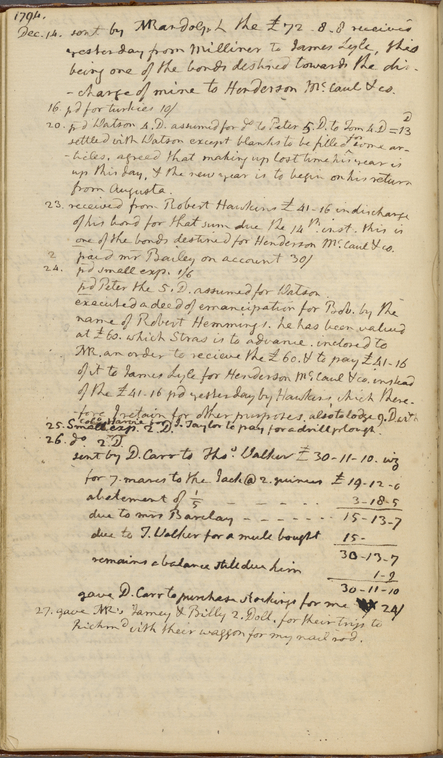Traces from Jefferson's Account Book: The Hemings Family
This is the first post in a series that will examine strands of Thomas Jefferson’s life and world, from 1791-1803, through entries in his manuscript account book.
Thomas Jefferson wrote a lot. And he also received an astounding amount of correspondence. Unquestionably, Jefferson is among the most well documented men of his generation. The editors of the Papers of Thomas Jefferson at Princeton University collected some 70,000 documents from his early years through the end of his presidency in 1809. To date, they have produced forty-one volumes, and still have yet to publish the material from 1803-1809. A separate project at Monticello, tackling the papers from Jefferson’s retirement years, has produced fourteen of an anticipated twenty-three volumes.
Amid all of this Jefferson-mania, The New York Public Library has just digitized Jefferson’s manuscript account book from 1791 to 1803. The volume is basically a day-by-day running record of Jefferson’s transactions. I’ve already written before about the value of these kinds of organizational sources for understanding daily life in early America generally. It is especially important to understand Jefferson on this quotidian level precisely because historians know so much about Jefferson’s abstract political and philosophical views. The account book offers a glimpse of how Jefferson interacted with his world on a daily basis.
Moments and events that loom large in historians’ understanding of Jefferson appear in the account book like anything else, as a few lines of text next to a date. On December 24, 1794, Jefferson scrawled that he “executed a deed of emancipation for Bob. by the name of Robert Hemings. he has been valued at L60.” Next to February 26, 1796, Jefferson wrote that he “gave James Hemings on his emancipation” thirty dollars to cover his expenses to travel to Philadelphia. Robert and James Hemings were, of course, the half brothers of Jefferson’s wife, and the older siblings of Jefferson’s longtime mistress, Sally Hemings.
Harvard historian, Annette Gordon-Reed knows more about Jefferson and the Hemings family than anyone. Her book on the subject, The Hemingses of Monticello: An American Family, won both a Pulitzer Prize and a National Book Award. Gordon-Reed combed through piles of Jefferson’s writings and the records of Monticello to understand Jefferson’s complicated relationship with the Hemings family and the institution of slavery. But even for such a seasoned Jefferson scholar, references to Hemingses in the account book put the Jefferson-Hemings relationship in a new light. When asked to write about an item from the NYPL collection for Know the Past, Find the Future: The New York Public Library at 100, Gordon-Reed picked Jefferson’s account book. “It was fascinating—and moving,” she wrote, to find Robert and James Hemings “listed under their family name” in Jefferson’s handwritten index to the account book.
Thomas Jefferson account book 1791-1803, accounts February 1796

Robert and James Hemings’s manumissions were monumental moments in the history of the most famous enslaved family in American history. And they are critical pieces of evidence for understanding Jefferson’s relationship with Sally Hemings shaped Jefferson as a slaveowner. Powerful traces of this story are preserved alongside the mundane details of Jefferson’s life in this account book. Surely many other significant stories are as well.
Further Reading:
Annette Gordon-Reed, The Hemingses of Monticello: An American Family (New York: W.W. Norton, 2008). Julian P. Boyd, ed., The Papers of Thomas Jefferson (Princeton: Princeton University Press, 1950- ). J. Jefferson Looney, ed., The Papers of Thomas Jefferson: Retirement Series (Princeton: Princeton University Press, 2004- ). James a Bear, Jr. and Lucia C. Stanton, eds., Jefferson’s Memorandum Books: Accounts, with Legal Records and Miscellany, 1767-1826 (Princeton: Princeton University Press, 1997).
About the Early Manuscripts Project
With support from the The Polonsky Foundation, The New York Public Library is currently digitizing upwards of 50,000 pages of historic early American manuscript material. The Early American Manuscripts Project will allow students, researchers, and the general public to revisit major political events of the era from new perspectives and to explore currents of everyday social, cultural, and economic life in the colonial, revolutionary, and early national periods. The project will present on-line for the first time high quality facsimiles of key documents from America’s Founding, including the papers of George Washington, Thomas Jefferson, Alexander Hamilton and James Madison. Drawing on the full breadth of the Library’s manuscript collections, it will also make widely available less well-known manuscript sources, including business papers of Atlantic merchants, diaries of people ranging from elite New York women to Christian Indian preachers, and organizational records of voluntary associations and philanthropic organizations. Over the next two years, this trove of manuscript sources, previously available only at the Library, will be made freely available through nypl.org.
Read E-Books with SimplyE
 With your library card, it's easier than ever to choose from more than 300,000 e-books on SimplyE, The New York Public Library's free e-reader app. Gain access to digital resources for all ages, including e-books, audiobooks, databases, and more.
With your library card, it's easier than ever to choose from more than 300,000 e-books on SimplyE, The New York Public Library's free e-reader app. Gain access to digital resources for all ages, including e-books, audiobooks, databases, and more.
If you don’t have an NYPL library card, New York State residents can apply for a digital card online or through SimplyE (available on the App Store or Google Play).
Need more help? Read our guide to using SimplyE.


Comments
George Chalmers
Submitted by Fletcher Crowe (not verified) on July 28, 2015 - 9:54am
Thank you, NYPL!
Submitted by Billy Wayson (not verified) on September 22, 2015 - 1:35pm